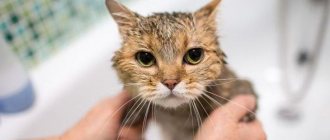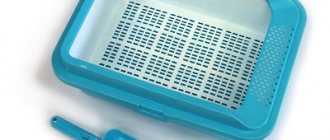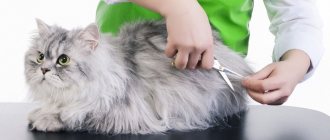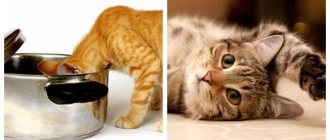The vet talks about the problem!
Everyone knows from childhood how important hygiene procedures are. We are used to taking a shower every day, or even a couple of times a day. But what about the hygiene of our favorite cats? On the one hand, cats lick themselves, on the other, do they need to be bathed at least sometimes?
Any owner sooner or later wonders whether it is necessary to wash a cat if it is a domestic cat. In this article we have collected the main recommendations of veterinarians and groomers .
Do domestic cats need to be washed?
After the kittens are born, the mother cat takes care of their washing. The kids learn from her and later cope with hygiene on their own.
Even kittens left without a mother know at the level of unconditioned reflexes that they need to lick themselves. However, each organism is individual, and there are exceptions.
Also, cats are unable to cope with some types of pollution or it takes them a long time.
Situations in which you need to wash your cat:
- The appearance of an unpleasant odor from the skin and fur.
- Presence of obvious contamination.
- Discharge from illness: blood, pus, leakage of urine or feces.
- Before participating in exhibitions.
- When prescribing medicated shampoos by a doctor.
When not to wash your cat:
- During severe acute illnesses.
- At high or low temperatures.
- 2-3 days before and after treatment against ectoparasites (fleas, ticks).
- Before visiting a veterinary dermatologist.
- When bathing is accompanied by severe stress.
How to bathe a small kitten
In this chapter you will learn how and at what age you can bathe kittens. Washing a kitten with water is not much different from washing an adult cat. You need to follow the same rules of a calm environment, encouragement, and use only special shampoos. It is better to bathe a kitten not in the bathtub, which can be intimidating for him, but in a sink with a small amount of water. The first bath should take place no earlier than 8 weeks from birth, i.e. when the kitten is 2 or more months old. Small kittens should be bathed no more than once a month.
The sooner you start bathing procedures, the faster your pet will get used to it and will show less resistance.
To wash the kitten, use a container that is more suitable in size.
If the kitten's front paws do not touch the water while bathing, he will feel more confident. While washing, hold your pet by the scruff of the neck, this will calm him down, because his mother usually does this. At some points, the kitten may experience panic attacks. To calm it down, pet the cub and talk to it in a gentle, quiet voice. Be sure to reward the kitten with a treat and encouragement at the end of the procedure. A fragile little kitten can easily catch a cold. Protect from drafts. Don't skimp on towels for him and wrap him in a warm, soft blanket where he can dry comfortably.
How often should a cat living in an apartment be washed?
How to determine how many times to wash a cat? An ordinary domestic cat that is groomed regularly, has a neat coat and does not have an unpleasant odor does not need to be washed.
If the owner has a desire to bathe the pet, then there is nothing wrong with that. But you shouldn’t get carried away with everyday water procedures.
ON A NOTE! It is recommended to wash your cat no more than once a week. For skin diseases, the doctor may prescribe treatment procedures every 3-4 days. Do not get carried away with frequent bathing, but also do not bring the animal to a critical condition.
Some owners prefer to bathe the cat once a year, for example after visiting the cottage .
When there is no special shampoo - what to do?
If there is no special shampoo, the best solution is to postpone bathing. But if this is not possible, use baby shampoo or baby soap for babies under three years of age.
You can also make your own cat shampoo. You will need 1 liter of warm water, 1/3 cup of apple cider vinegar and a bottle of glycerin (80g). Mix all ingredients thoroughly and use as needed. Store in a tightly closed container away from direct sunlight. Do not add fragrances or essential oils to your shampoo.
Apple cider vinegar makes fur smooth and shiny
Let's figure out how often you need to wash a Scottish Fold cat and the characteristics of other breeds
There are exceptions to every rule. Hairless cats and, conversely, cats with rich fur often need hygiene procedures.
Sphynx cats, for example, produce large amounts of sebum and, in order to avoid the formation of acne, it is recommended to wash them more often than, for example, a domestic shorthair.
The Scottish Fold cat does not need to be washed at all, it all depends on the individual characteristics of the cat.
However, there are obese individuals who find it physically difficult to reach certain parts of the body to wash themselves. In this case, in addition to taking baths, it is recommended to keep your cat busy with physical activity.
If the owner cannot cope on his own, then for such pets there are veterinary centers with a grooming salon and a gym.
Watch the video: SHOW CLEARLY - How to bathe a cat
Tar soap for fleas in cats: how to use?
Tar soap based on birch tar contains natural substances that have disinfestant properties. It is believed that it can remove fleas from cats.
Tar soap is used against fleas on cats.
IMPORTANT: Yes, tar soap against fleas helps, but the procedure will have to be carried out several times, perhaps a lot. The soap solution washes out or kills fleas, but not their eggs. Frequent bathing is harmful for cats; it is preferable to use modern means that get rid of fleas in 1-2 applications.
If you still decide to remove fleas from a cat with tar soap, it is done like this:
- Prepare a soap solution. 0.25 soap is grated and completely dissolved in 200 ml of warm water.
- Moisten the cat's fur with regular warm water.
- Treat the wool with a solution of tar soap so that it gets on the skin. Thoroughly wash the folds of the paws, under the tail, neck and withers.
- Keep the animal in a soap solution for 5-10 minutes.
- Carefully wash off the tar soap from the cat's fur.
- Repeat the procedure every 2 weeks as necessary (it is in 2 weeks that flea eggs hatch).
IMPORTANT: Even after thorough rinsing, a specific smell of tar soap remains on the animal’s fur, which can cause discomfort to the animal. If a cat does not respond well to the procedure for removing fleas with tar soap, it is better not to repeat it and choose another product.
How to wash a cat with shampoo for the first time? Choice of product
If you decide to give your kitten a bath, or if circumstances arise that you need to wash an adult cat for the first time, then you need to approach this responsibly.
There is no need to throw your pet into a bath full of water or direct the shower jets. The cat will most likely become frightened and may injure you and itself.
Take the cat in your arms and stroke it. Turn on the water and let your pet get used to the noise.
For comfortable bathing, so that the cat does not jump out of the bath, there are special nets with attachments for washing animals; they can be purchased in online stores.
After the pet has gotten used to the water, you can apply shampoo to the fur and lather the pet. It is worth noting that products for animals foam worse than for people. This is fine.
Sometimes you need to soap the cat and wait 10-15 minutes, then rinse off the product. More often this applies to medicated shampoos. There are also balms and foams for easy combing and caring for your pet’s skin and fur.
If the cat is not too dirty, but you need to give it a pleasant aroma and a well-groomed appearance, but you can’t give it a bath, then don’t worry. There are special dry shampoo powders. They are applied to the wool and then combed out.
What else should you pay attention to when choosing shampoo for cats ?
There are detergents for different types and lengths of wool. After all, the hair of a Persian cat and a Cornish Rex is significantly different. Also, products for humans or other animals are not suitable for cats, since the pH of their skin is different.
What happens if you use the wrong shampoo?
Often the veterinarian hears that someone bathes a cat with baby soap or human shampoo and everything is fine.
Some people are really fine, their skin is fine, but in other animals the skin dries out or, on the contrary, excessive secretion of the sebaceous glands occurs, dandruff forms, and the quality of the coat deteriorates.
How to wash your cat's eyes and ears
To rinse your cat's eyes, prepare a rinse solution and cotton pads or cotton balls. As a solution, you can use ordinary boiled warm water, water with the addition of chlorhexidine or hydrogen peroxide (1 teaspoon per glass of water), a decoction of medicinal herbs or tea leaves.
Soak cotton wool in the solution and apply it to the eye for a few seconds to soak all dried dirt (pus, discharge, tears), remove dirt. Using new moistened cotton wool, rinse your eye from the inner corner to the outer corner.
When wiping, be careful not to press too hard on your eyes.
To clean your cat's ears, it is recommended to use special ear cleaning products. They contain antifungal and antibacterial ingredients that protect against infections.
Lotion for hygienic treatment of pet ears
Fold your ear over to open the ear canal. Pour a little solution onto a cotton pad or ball, and, wrapping it around your finger, go through all the folds inside the ear. Soak a new cotton ball with the solution and place it inside your ear, massaging the ear from below. Take out the ball. After the procedure, wash your hands thoroughly. Be sure to reward your pet with a treat at the end of the procedure.
Do not use cotton swabs to clean your ears. You can damage your eardrum
Seasonality. Is it possible to wash cats in winter?
You can bathe cats at any time of the year. However, it is important to understand that cats with long hair take longer to dry.
Kittens are very small, and if they are not kept dry, they can become hypothermic, especially in winter.
Therefore, after bathing, be sure to dry your cat and, if she is not afraid, then dry her with a hairdryer. Never let a wet cat outside!
Also, the cat should not lie on the cold floor. It is not recommended to wrap your cat in a towel or blanket for a long period, as this will slow down the drying process and can also lead to hypothermia.
Otherwise there are no restrictions.
Are there any contraindications?
Bathing usually causes stress in animals. This is not dangerous for healthy cats, especially since they get used to it over time. But for cats suffering from illnesses, bathing can aggravate symptoms. Check with your veterinarian to see if bathing is appropriate for your pet.
Washing pregnant and lactating cats with water is contraindicated. Stress can lead to miscarriage, abnormal fetal development, and loss of milk.
Do everything you can to make your pregnant cat comfortable and don't put her under unnecessary stress.
Do not bathe your cat after eating, as this can cause digestive problems, nausea and vomiting.
If it didn’t work out on your own
If your pet is significantly dirty, does not allow itself to be washed, burdock or other debris is tangled in its fur, and you cannot cope on your own, then you should not torture yourself and your pet.
There are grooming salons for professional hygiene procedures. This is, one might say, a hairdressing salon for animals. If there is no such thing nearby, then you can contact a veterinary clinic.
ON A NOTE! In addition, there are groomers who work from home : they simply come to your apartment and cut the animal on the spot. It’s convenient to work with such a professional - you don’t have to travel anywhere, and the cat will be in comfortable conditions.
Is it possible to bathe a cat in the heat?
If a cat suffers from the heat in the apartment in the summer, the owners may want to give it a bath to refresh it. But frequent bathing, as is already known, can be harmful. Therefore, “refreshing procedures” are recommended to be carried out as follows:
- place a wet towel within reach of the animal so that it can lie on it or wet its paws
- spray the cat with water from a spray bottle
- wipe the cat's head and paws with a damp cloth
And even in these cases, the water should not be very cold so that the cat does not catch a cold.
Where to go in Moscow?
- Fluffy happiness. Addresses:
- N. Cheryomushki, st. Garibaldi, 15.
- st. Kastanaevskaya, 17.
In addition to highly qualified groomers, a veterinary office is open here twice a week. There is a large selection of accessories, clothing and pet comfort products.
- Chain of pet salons Baluti.
Addresses of pet salons:
- M. Kuntsevo, Kastanaevskaya, 58.
- m. Marksistskaya, Ryazansky Ave.
- m. Varshavskaya.
- m. Tulskaya.
- m. Shchelkovskaya.
In salons there are discounts on services for kittens, check with the administrator. There is also a late appointment for busy people, but be careful, the cost of procedures will be increased by 50%.
In addition, there is a service to call a master groomer to your home. If you have a long-haired cat, you can handle it yourself - just read our article .
Watch the video: MY CAT - See how to do it correctly
Kitten's first bath
You should start bathing a kitten at 4 months of age, not earlier. Babies are extremely sensitive to temperature changes, and improper bathing can lead to serious consequences.
You can start training 2 weeks after the complete change of teeth. For the process to go smoothly, you need to convince the kitten that water is not dangerous. To do this, place a bowl of water in the room and throw rubber toys there. The baby will become interested and try to play with them.
Then you can wash your paws, under the tap or in a basin. Pour some water into it and place the kitten. If the baby does not run away in panic, he is already ready for water procedures.
If fear is present, you can distract your baby with squeaky toys while washing. If you have a helper, ask him to blow soap bubbles. While the kitten is watching them, you can have time to wash it completely.
Where to go in St. Petersburg?
- MasterGroom chain of salons.
Addresses of pet salons:
- Degtyarny lane, house 20.
- Kondratyevsky Prospekt, house 64, building 2.
- Bolshevikov Avenue, house 38, building 5.
- Yuri Gagarin Avenue, 14, building 6.
- Listvennaya street, building 18, building 1.
There are discounts in salons. Meeting the master 10%, writing a review 5%.
- Salon Fox. In the market of pet products and services for more than 12 years. In addition to grooming, there is a veterinary pharmacy and a large selection of hygiene products for caring for your pet’s skin and coat.
Addresses of pet salons:
- st. Communes no. 59 (Krasnogvardeisky district, on the territory of Rzhevka).
- st. Leningradskaya 7 (Novy Okkervil microdistrict, Vsevolozhsky district, Kudrovo village).
Features of bathing long-haired cats
In fact, this was the simplest algorithm for bathing pets, designed so that the pet does not cause much trouble during water procedures. In order not to be afraid that the animal may escape, some owners use special clamps that are attached to the bathroom wall with a suction cup. Such a device does not strangle the animal, and at the same time holds it.
If your pet's fur is tangled or matted, it is better to comb it out or even give it a manicure and pedicure with special scissors. To better remove dirt, apply a degreasing paste to the collar area, behind the ears and on the tail. If you don’t yet know how often you need to wash your cat, we recommend going through this procedure from start to finish.
Perhaps you simply do not have the skill and time to wash your animal as often as you would like. After applying the paste, carefully rinse it off with water. The animal's ears can be covered with your hands. Next, apply a degreasing shampoo and rinse several times. It is believed that the rinsing procedure must be repeated until the characteristic “creaking” of the fur appears.
After shampoo, you can apply conditioner to prevent the coat from drying out. We wash off the balm in the same way and let the water drain a little. The animal's fur is carefully blotted, for which you can use several different towels. Now you can remove the animal from the restrainer and move it to the place where we will dry and comb the cat. Of course, such a complicated procedure is especially in demand among owners of long-haired dogs that require special care.
Where to go in Rostov-on-Don?
- Salon Matilda. Address: st. 1st Cavalry Army, 15th century.
In addition to a wide range of grooming services, the salon is a school for master groomers. Specialists from different cities of Russia flock here for primary training and advanced training.
- Zoo. Address: st. 1st Cavalry Army, 15th century.
All procedures are performed without the use of anesthesia or sedatives. Promotions are held periodically and you can get discounts on services. Pre-registration available. It is better to clarify the details by calling the salon.
Read other articles on the Guardian of Purity portal. We care about the health of our four-legged friends. Stay with us!
Quantity
Is it possible to bathe a cat during heat?
You can bathe a cat during a difficult period of estrus; the procedure will not harm her. Moreover, some owners have noticed that after bathing their pets are so busy licking that they even calm down for a while. But this does not mean that water procedures can be performed every day. They resort to them only once.
Bathing during heat distracts the cat.
Should you bathe your pet?
It is important to remember that bathing is not a necessity for felines like it is for most dogs. Only cats of some breeds, such as Devon Rex or Sphynx, need periodic bathing. If this is relevant to you, read my article on what breed of cats to choose for an apartment.
Cats should only be washed in exceptional cases:
- if you adopted a cat from the street;
- if the cat is tormented by parasites;
- if the animal is dirty;
- if the pet participates in an exhibition where the condition of its coat can lead to victory
Regular washing removes the protective antibacterial layer from the fur, which can also be called the cat's immunity against parasites.
After the bath
If the cat is not afraid of the sounds of a hair dryer, you can dry its fur by turning the device on to low air flow mode. As a rule, most pets do not lend themselves to such drying, so there is nothing else left to do but to give the cat the opportunity to get rid of excess moisture on the body on its own. By placing him near a warm radiator on a soft, cozy rug, the cat will soon become completely dry. The main thing is not to create drafts in the room and not to open the windows so that the animal does not catch a cold.
Returning to the issue of bathing babies, it should be noted that there is nothing wrong with not bathing a kitten for the first three to four months of its life. And although experts do not recommend bathing your baby too often, in practice it turns out a little differently. Kittens are clumsy and not neat: they either get dirty in the tray or end up in a flower pot. Therefore, you should not worry about the frequency of bathing events. A grown animal can be bathed depending on the degree of contamination of its fur. Therefore, there cannot be a specific schedule for washing a cat.
We recommend reading: Why cats are afraid of water and basic recommendations for bathing
Preparation for the process
So, having purchased a suitable shampoo, the moment of bathing comes. Putting all worries aside, you need to prepare the room for bath procedures. It is advisable to remove everything that could interfere in any way: creams, shampoos, towels, etc. Leave only the essentials: a bottle of shampoo for your pet, a separate towel for the animal.
All caring owners are interested in how to bathe a cat without scaring it with water, but a common mistake most owners make is choosing the water temperature for their four-legged cat. Water between 33-35 degrees is considered optimal. Too hot water at the first bath can cause unpleasant sensations in the animal and fear of their repetition in the future.
How to wash your beloved pet?
Directly washing the cat should be done in a filled bath. Although a shower is much more suitable for this purpose, since it is easier to hold a pet by directing one stream at it. Immersion in water should occur gradually. It is advisable to take the cat by the scruff of the neck (it is unlikely to scratch someone and break free in this way) and sit it in the bathtub. You need to wet your entire body, leaving your nose and ears untouched.
Now you can start applying the shampoo, continuing to hold the cat with one hand and foaming the detergent with the other. If the cat behaves approximately, then you can put it on its hind legs and gently massage the foam onto its chest and stomach. After washing your body with your hands or using a soft special washcloth, you should start washing your hair. It is at this moment that many owners often have difficulties, so you need to be extremely careful when washing.
Washing a human head is fundamentally different from bathing a cat, primarily in that the animal must be protected from water getting into its ears. In fact, you only need to wash the space between the ears and the neck area. Having carefully washed off all the foam from the fur and finished the bathing process, the cat must be wrapped in a prepared towel, hugged and allowed to feel safe.
Drying wool after bathing
After washing, take a towel and gently blot the animal's fur with it. Wring it out, wrap the cat in a towel and wipe with light massaging movements. When it gets very wet, take another dry towel and wrap your pet in it.
After this, the cat can be taken out of the bath and placed on a dry towel. Make sure that the balcony and windows are closed. If the cat has long hair, you can brush the fur until it dries. The procedure will not only speed up drying, but will also make it easy to get rid of knots if they appeared during the washing process. It is better not to use a hairdryer.
Praise the cat
After bathing, be sure to praise the cat, pet him, and tell him how good he is. Give a favorite treat, catnip, or another treat that you rarely give on special occasions. If your cat associates washing with a reward, he will be more willing to bathe.











